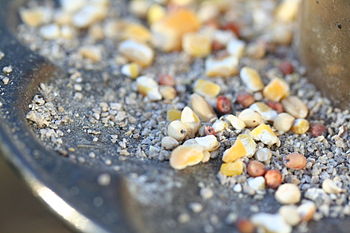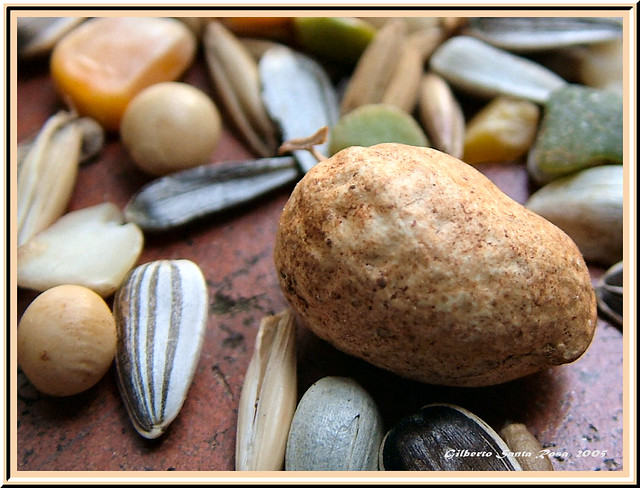 |
| An Acorn Woodpecker feeding on a bird feeder in Arizona, USA. (Photo credit: Wikipedia) |
Bird Feeder Basics When you shop for bird feeders, you'll find your choices are almost limitless. You may wonder how to decide what to buy. Here are some hints.
Ease of use - The most important factor in choosing a feeder is how easy it is to use - for both the owner and the birds. You want a feeder that's easy to fill and that holds a reasonable amount of seed. If you are just getting started, look for a feeder that displays seed in full view because birds are attracted by the sight of food and by the sight of other birds eating. An open tray is great for starters.
Make sure your bird feeder has plenty of room for birds to eat without protrusions or decorations getting in the way. Birds also like a feeder with a raised ledge or perch that they can grasp while eating.
Size - When birds come to a bird feeder, they want food, and they wait for it fast. Choose a main tray feeder that's big enough for at least a dozen birds to eat at once. Supplement that with a hopper- and tube-type bird feeders. Domed feeders are great for small birds like chickadees. Feeders inside wire cages give small birds a place to eat and peace without competition from starlings or other larger birds. Once you have one or two large bird feeder you can add as many smaller feeders as you like.
Quality - Make sure your bird feeder is well made. A sturdy, simple, but beautiful feeder costs more than you'd think. Expect to pay $30 - $75 for a feeder that will last for years.
Tray (Platform) Feeders A must have for any backyard is a simple wooden tray feeder. It's big, it's easy to fill, and it accommodates several birds. The other feeders pick up the overflow and they can be stocked with treats. Cardinals, finches, jays, grosbeaks, bluebirds, blackbirds, nuthatches, chickadees, titmice, and buntings all prefer an open tray feeder. The only birds reluctant to us a tray feeder mounted on a post are ground-feeding birds. A very low tray on stumped legs will accommodate these birds, which include native sparrows, quail, towhees, and doves. You can put any kind of seed in a tray except for small Niger, lettuce, and grass seeds, which are prone to blow away or get wasted. Platform feeders are also good places to put out doughnuts, bread crumbs and fruit.
Platform feeders with a roof are often called fly-through feeders. One problem with tray feeders is that plenty of seed gets kicked to the ground. Adding raised edges to a platform feeder transforms it into tray feeder.
Tray feeders can be hung. A popular hanging model, the Droll Yankees X-l Seed saver is protected by a dome to keep seed dry and prevent squirrels from raiding. This feeder works especially well as a mealworm feeder.
Hopper Feeders Hopper-style bird feeders with plastic or glass enclosures that dole out seed as they're needed are an efficient choice because the seed is used as needed and large amounts aren't exposed to wet or snowy weather or kicked out by scratching birds. Many birds, including chickadees, nuthatches, titmice, cardinals, jays, and woodpeckers, eat eagerly at a hopper feeder. Make sure the tray of a hopper-style bird feeder has enough room for more than two or three birds to gather and eat and check to see if the feeder will be easy to clean if seed spoils in bad weather. Be especially careful if you mount your hopper feeder permanently in the garden. If the hopper or frame blocks the tray, the feeder may be very hard to clean.
Hopper feeders are not always rectangular. They can be many-sided or tubular, resembling a gazebo, lantern, or silo, and may be called by those names. A popular round hopper design is the Sky Cafe by Arundale, a hanging feeder made entirely of clear polycarbonate. The hopper and feeding platform are protected by a large, steeply sloped hood designed to detour squirrels. The idea of a large dome above a feeder to protect it from squirrels is incorporated in a number of feeder designs, including Droll Yankees' Big Top.
 |
| House Sparrows at a bird feeder (Photo credit: Wikipedia) |
One of the most significant innovations in hopper feeders has been the "squirrel-proof" models created by Heritage Farms, such as The Absolute II. Birds must sit on a rail to reach the seed tray. The rail has a counterweight that can be adjusted so that a squirrel's weight or that of a jay or blackbird will cause the shield to lower in front of the tray.
Wire-Mesh Feeders Perfect for holding shelled peanuts wire-mesh feeders are fun to watch. Blue jays, woodpeckers, and chickadees can cling to the mesh and pick seeds out one at a time. Squirrels can pick seeds too, but one seed at a time can be painfully slow. Wire-mesh feeders work equally well dispensing black oil sunflower seeds and most other larger seeds. Small, round millet grains pour through the openings and are not a good choice for these feeders.
Most commercial wire-mesh feeders are tubular, but some are shaped like hoppers and may be attached to a platform where birds can perch to feed, rather than having to cling to the mesh.
Mesh bags, often called thistle socks, are also available for dispensing Niger seed. Refillable socks made of fabric and disposable ones made of plastic are available. Squirrels or rain can quickly ruin thistle socks, so hang them in a protected place.
Window Feeders Years ago, before the fancy screens and storm windows, many people simply scattered a handful of crumbs or seeds for the birds on their windowsills. You can mount a simple shallow tray feeder on the outside of a window, mounting it like a window box (but higher and closer to the pane). You can use wooden or metal brackets that attach below the sill or on the sill. Perfect for kids and indoor cats - many window feeders attach with suction cups. Typically made of clear plastic, models by Aspects, Duncraft and K-Feeders are among those available.
The most popular window feeders are made by Coveside and the Birding Company. A one-way mirror allows the feeding activity to be observed while keeping the birds from being disturbed. The feeders need to be placed in a sunny spot for the one-way mirror to work. The feeder can be cleaned and food replaced from inside the house.
Tube Feeders Simple tube feeders are a perfect example of form matching function. They're self-contained, so seed stays dry; they hold a good quantity of seed, so they don't need refilling too often, and they can accommodate several birds at one time. Not all tube feeders are created equal though. You should invest a few extra dollars in the more expensive feeders such as Duncraft or Droll Yankees. The tube itself is sturdier, the feeding holes are designed better so there's less spillage or feeds as birds eat, and the heavier metal used on top and bottom makes the feeder much more stable. Being heavier they don't swing as easily in the wind scattering seed on the ground.
Tube feeders are welcomed by goldfinches, purple finches, pine siskins, chickadees, and house finches, who seem to know they can eat in peace there without being disturbed by the bigger birds. The size of the hole (port) determines whether you have a feeder that should be filled with Niger, birdseed mix or sunflower seeds.
There are two styles of tube feeders. One is designed with small feeding ports for the tiny Niger seeds; the other has larger ports for such seeds as black oil sunflower, safflower, or mixed seed.
Not all tube feeders are cylinders. There are tube feeders with three, four, or more sides. It is the idea of feeding ports built into the elongated seed container that makes a feeder a tube feeder.
The Droll Yankees A6 Tube Feeder is still a top seller. Droll Yankee feeders have a lifetime guarantee. Other variations include Perky Pet's Upside-Down Thistle Feeder. Perches are placed above the feeding ports so that seed can be accessed only by finches that can feed upside down, a design that excludes house finches.
Two or three tubes are sometimes ganged together, as the Opus TopFlight Triple Tube Feeder. With a total of 12 ports, it can feed more birds than a single tube, and it also has the option of being filled with a different seed type in each tube.
Most tube feeders are made of transparent plastic, but Vari-Craft makes particularly attractive tube feeders of white PVC. Ports are made of a hard plastic. A squirrel-proof model is available with stainless steel ports.
Most tube feeders can be fitted with round trays underneath that catch spillage from birds like finches, which are notoriously messy eaters. The tray serves double duty as a small platform feeder for such birds like cardinals and doves, which benefit from the slung seed.
Tube feeders are sometimes placed inside a wire-mesh cage for protection from squirrels. Cages also keep large birds like grackles from perching on a tray and reaching up to the feeder ports.
Nectar Feeders Sweet sugar water, or nectar, is a huge draw for hummingbirds. Put up a nectar feeder and you're practically guaranteed to get hummers. The bird's search for red and deep orange-red flowers, and anything that color will bring them in for a closer look. Your nectar feeder may also attract other birds with a sweet tooth, including orioles, house finches, and woodpeckers. In the wild, these birds would satisfy that craving with real nectar from flowers, or a sip of sugary tree sap or fruit juice. The sugar boost gives them quick calories and the energy needed to live.
As with other bird feeders, look for a nectar feeder that's easy to fill and easy to clean. Make sure you can remove the base to clean out the feeding holes. Bee guards of gridded plastic over the feeder openings are a necessity unless you like to watch constant battles between wasps and hummingbirds.
Suet Feeders Suet feeders are not nearly as complex as some seed feeders. They can be as simple as a mesh sack - the kind often used for onions and potatoes. Toss a chunk of raw suet in an empty mesh sack and hang it on a tree trunk or from a branch or pole.
A popular way of presenting suet is in homemade suet logs. Perches are not necessary and if used will attract grackles and starlings. Woodpeckers and small clinging birds can get a grip on the rough wood. Stuffed with suet, these logs have woodpeckers as regular visitors. Standing dead trees can be drilled and filled like giant suet logs. If meant to attract woodpeckers, a suet feeder is likely to be found most quickly if it is attached initially to a tree trunk. Once the woodpeckers have found it, the feeder can be moved to other spots and the birds will follow.
Suet cages are sometimes combined with bird feeders. Health Manufacturing makes a beautiful redwood hopper feeder with suet cages at either end, the Classic Suet and Seed Feeder. Woodlink makes a similar model with a copper roof.
Author: Louise Desmarteau






